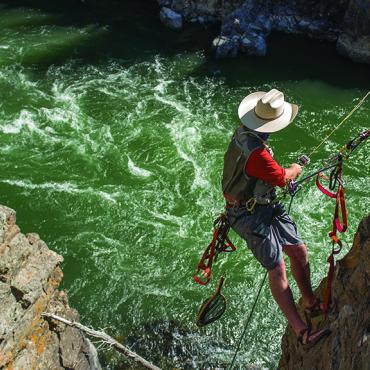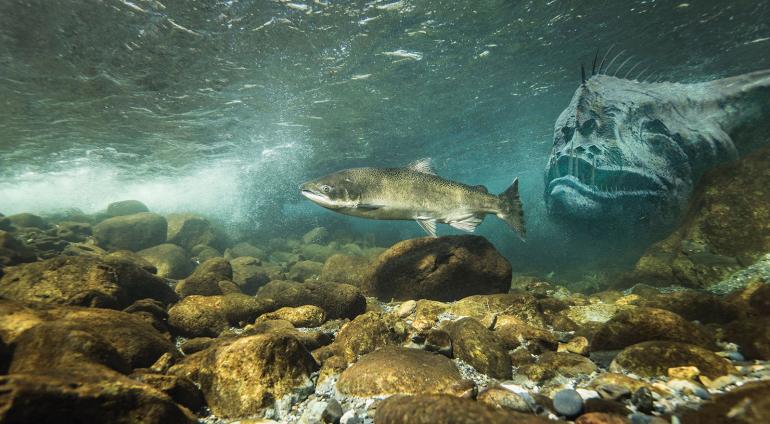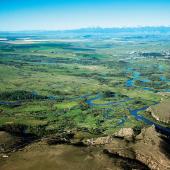Under the Bridge
Strange fish sightings in the Gallatin Valley.
Southwest Montana is home to an abundance of apex predators, with grizzly bears, mountain lions, and wolves all sharing the same landscape. And if recent reports are true, there’s a new carnivore to add to the list, one that appears every bit as formidable as the rest.
Sightings are rare, but this much we know: it lives in the water and has a fearsome appearance. “It looks like a demon,” said one frightened fisherman who refused to give his name. “I don’t want to sound like some scaredy-cat from California, but the thing really creeped me out. I haven’t gone back to that spot since.” With more and more stories circulating, locals have given the animal a name that seems fitting: aqua cabra.
The first reported sighting came in May, from Bozeman patchouli farmer and whitewater kayaker, Luna Teeke, near the 35mph bridge in Gallatin Canyon. “I was just scrambling along the bank, looking to scout the rapids above House Rock,” Teeke said. “All the sudden, BAM—this big nasty thing exploded out of the water, chomping at my foot.”
Luckily, Teeke’s quick reactions allowed her to escape up the bank, but the experience left her in shock. “It was the most vile and terrifying experience I’ve ever had,” she explained with a shudder. “And I’ve been face-to-face with a grizzly.” Teeke’s entire lower leg was covered in contusions and lacerations, confirming the threat this creature presents. “Whatever it was, it got my toe for sure,” Teeke said. “But who knows about the bruises, that could’ve been delayed-onset boot-bang from last winter. I was pretty freaking high, too.”
Amateur ichthyologist Harry Wynoe has followed the aqua cabra since 2018, after hearing an intriguing report near the mouth of the Mississippi. He was at a New Orleans watering hole when a fisherman described a “bizarre creature, maybe four feet long, spines like a sea urchin, the whiskers of a catfish, body of an eel, gnarly teeth, and a disturbingly massive underbite.”
Initially dismissing the fish as a mutated snakehead, Wynoe soon realized there was more to the story. “I joined the fisherman at the bar, and after one boilermaker, the guy really started to open up,” he explained. “He got animated and emotional. That’s when I knew I was onto something.” Wynoe’s scientific instincts told him to move upstream; a year later, he met a St. Louis resident with a similar scarring account while bathing in the Missouri. Diligently visiting small-town bars along the way, Wynoe eventually wound up at the Sip ‘N’ Dip in Great Falls, where he hit pay dirt: several sightings from multiple fishermen, plus a guy named Gary who sells driftwood on Etsy. “People are naturally tight-lipped about stuff like this,” he explained, “but after each round of Old Crow, another guy would tell me a similar story, each one crazier than the last.”
Given the lack of reliable photographs, skeptics abound. The most common challenge to Wynoe’s findings, apart from the beer stains on the manuscripts he sends to scientific journals, is this: how did a fish get past all the dams between here and the Mississippi Delta?
Wynoe has an answer, albeit a troubling one: the creature can walk on land. “I got a tip that a local had seen one near Townsend,” he said. “I bellied up at the Bunkhouse Bar for three days until the guy showed up. He was reticent at first—nobody wants people to think he’s some desperate backwoods wannabe hoping to get his own Discovery Channel show—but after a half-bottle of Early Times, he shared his experience.” Turns out the fellow spotted an aqua cabra crawling out of the river below the Toston Dam, while he was driving back to his squatter’s cabin after last-call. As the man looked out of his window, shocked, the creature slowly crawled past. “I know it sounds crazy,” he said, under his breath, “but I swear the thing glared at me.”
During a recent interview, with bloodshot eyes and sluggish speech from many long nights of research, Wynoe took a serious tone. “Do you people have any damn idea what this means? The friggin thing could feashibly make it to Hiltite—I mean, Hylite. Imagine the college girls, swimmin’ in bikinis, with a friggin’ flesh-eatin’ monster in the lake? And those biology bozos think it’s somethin’ someone bought at Petco. It ain’t no aquarian fish!”
So, what to do, until we know for sure if this thing is real and how many of them are in our rivers? Without official guidance, locals are taking measures into their own hands. Waterproof cattle-prods have appeared in fly-shop inventories, though they’re not exactly on full display. “We don’t want to scare the out-of-state anglers,” said shop manager Dee Niall, “so we paint them pink and call them ‘Britney spears.’ I give them to all my guides. We tell our clients it’s a Montana-style wading staff, used to fend off aggressive cows along the riverbank, all while raising awareness of breast cancer.”
Along with specialized weapons, protective clothing can offer some security while fishing. Snake-proof chaps are popular, and the Rhino Wader by Simms, previously sold only in South America to ward off piranha, is in high demand. Last week, Sitka came out with an eco-friendly, Kevlar-lined wader called the Armadillo. Other popular precautions include frog spears, spiked sungloves, wasabi-tipped gaffing hooks, and fishing from drywall stilts.
More proactively, the local health department issued a public-safety announcement banning the playing of Marco Polo in swimming holes, citing the person playing Marco as especially vulnerable to attack. Additionally, the governor’s office is considering a protective-wader mandate for the entire Missouri River watershed. Phase 1 restrictions would only apply from 3-6pm, when most sightings have occurred.
On a national level, the U.S. Fish and Wildlife Service recently called professional spearfisherman Quint Deckard out of retirement. Deckard, with over 34,000 confirmed kills in Yellowstone Lake alone, was initially reluctant. “I’m not that kind of man anymore,” he said, referring to his 30-plus years of service. He issued the long, forlorn sigh of a man who’s seen it all. “But the last year’s been difficult, for all sorts of reasons. At the end of the day, I guess I’ll do whatever I have to for the greater good. Besides, my accountant says this will allow me to write off my latest toy, a lobster tickle-stick.”
Although the aqua cabra generally incites fear and loathing, Deckard sees promise. “Despite the rough times we’ve all been through lately, in some strange way I feel like this god-awful creature is bringing us together.”
Deckard may be right—the day after Teeke reported her sighting, groups of all kinds began to emerge. Facebook pages, safety coalitions, ad hoc extermination committees—all bipartisan. The Gallatin Foreign Fish Partnership, a diverse group of stakeholders, has prepared a 20-page report on appropriate actions to deal with the threat.
“We’ve been granted something we haven’t had since World War II,” Deckard said. “A common enemy. And to not take advantage of that would be a damn shame.”
Have you seen an aqua cabra? If so, or to learn more, visit aquacabra.org.














